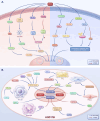Decoding the enigmatic estrogen paradox in pulmonary hypertension: delving into estrogen metabolites and metabolic enzymes
- PMID: 39695964
- PMCID: PMC11653592
- DOI: 10.1186/s11658-024-00671-w
Decoding the enigmatic estrogen paradox in pulmonary hypertension: delving into estrogen metabolites and metabolic enzymes
Abstract
Pulmonary hypertension (PH) presents a puzzling sex bias, being more prevalent in women yet often less severe than in men, and the underlying reasons remain unclear. Studies using animal models, and limited clinical data have revealed a protective influence of exogenous estrogens, known as the estrogen paradox. Research suggests that beyond its receptor-mediated effects, estrogen acts through metabolites such as 2-ME2, 4-OHE2, and 16-OHE2, which are capable of exhibiting protective or detrimental effects in PH, prompting the need to explore their roles in PH to untangle sex differences and the estrogen paradox. Hypoxia disrupts the balance of estrogen metabolites by affecting the enzymes responsible for estrogen metabolism. Delving into the role of these metabolic enzymes not only illuminates the sex difference in PH but also provides a potential rationale for the estrogen paradox. This review delves into the intricate interplay between estrogen metabolites, metabolic enzymes, and PH, offering a deeper understanding of sex-specific differences and the perplexing estrogen paradox in the context of this condition.
Keywords: CYPs; Estrogen; Estrogen metabolites; HSD17B; Hypoxia; Pulmonary hypertension.
© 2024. The Author(s).
Conflict of interest statement
Declarations. Ethics approval and consent to participate.: Not applicable. Consent for publication: Not applicable. Competing interests: The authors declare that there is no conflict of interest.
Figures





Similar articles
-
Progress in solving the sex hormone paradox in pulmonary hypertension.Am J Physiol Lung Cell Mol Physiol. 2014 Jul 1;307(1):L7-26. doi: 10.1152/ajplung.00337.2013. Epub 2014 May 9. Am J Physiol Lung Cell Mol Physiol. 2014. PMID: 24816487 Review.
-
Estrogen paradox in pulmonary hypertension: current controversies and future perspectives.Am J Respir Crit Care Med. 2012 Jul 15;186(2):125-31. doi: 10.1164/rccm.201201-0058PP. Epub 2012 May 3. Am J Respir Crit Care Med. 2012. PMID: 22561960 Free PMC article. Review.
-
Estrogens and development of pulmonary hypertension: interaction of estradiol metabolism and pulmonary vascular disease.J Cardiovasc Pharmacol. 2010 Dec;56(6):696-708. doi: 10.1097/FJC.0b013e3181f9ea8d. J Cardiovasc Pharmacol. 2010. PMID: 20881610 Free PMC article. Review.
-
Sex-dependent influence of endogenous estrogen in pulmonary hypertension.Am J Respir Crit Care Med. 2014 Aug 15;190(4):456-67. doi: 10.1164/rccm.201403-0483OC. Am J Respir Crit Care Med. 2014. PMID: 24956156 Free PMC article.
-
Sex, Gender, and Sex Hormones in Pulmonary Hypertension and Right Ventricular Failure.Compr Physiol. 2019 Dec 18;10(1):125-170. doi: 10.1002/cphy.c190011. Compr Physiol. 2019. PMID: 31853950 Free PMC article. Review.
Cited by
-
LONP1 facilitates pulmonary artery smooth muscle cell glycolytic reprogramming by degrading MPC1 in pulmonary hypertension.Clin Sci (Lond). 2025 May 20;139(10):479-501. doi: 10.1042/CS20255922. Clin Sci (Lond). 2025. PMID: 40332105 Free PMC article.
-
Signaling pathways and targeted therapy for pulmonary hypertension.Signal Transduct Target Ther. 2025 Jul 1;10(1):207. doi: 10.1038/s41392-025-02287-8. Signal Transduct Target Ther. 2025. PMID: 40588471 Free PMC article. Review.
References
-
- Mocumbi A, Humbert M, Saxena A, Jing ZC, Sliwa K, Thienemann F, Archer SL, Stewart S. Pulmonary hypertension. Nat Rev Dis Prim. 2024;10(1):1. 10.1038/s41572-023-00486-7. - PubMed
-
- Hansmann G. Pulmonary hypertension in infants, children, and young adults. J Am Coll Cardiol. 2017;69(20):2551–69. 10.1016/j.jacc.2017.03.575. - PubMed
-
- Dodson MW, Brown LM, Elliott CG. Pulmonary arterial hypertension. Heart Fail Clin. 2018;14(3):255–69. 10.1016/j.hfc.2018.02.003. - PubMed
Publication types
MeSH terms
Substances
Grants and funding
LinkOut - more resources
Full Text Sources
Medical

